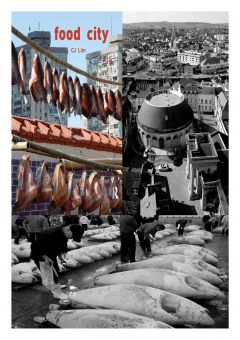Food City

Food City builds on several years of research on the intersection of food with urban planning and policy. This research, through a discussion of city-level realities and initiatives, explores food and its links to business, community, culture, education, employment, energy, health, law and transport. For instance, Lim describes the Restaurantes Populares, or “People’s Restaurants”, in Belo Horizonte, Brazil. This effort to reduce food insecurity and poor nutrition provides one nutritious meal each day, subsidized by the local government. The Restaurantes Populares have led to an overall reduction in government spending on health care and social services. And because the meals are made available to everyone in the city, the project has avoided the stigma attached to other food security initiatives. Instead, the Restaurantes Populares are a means of promoting social cohesion.
Descriptions like these run alongside abundant photographs of urban food. Indeed, the first section of the book is given over to a pictorial essay of varied food practices around the world. Photos of food markets – such as the ones above of Cork’s Butter Exchange and Tokyo’s Tsukiji Fish Market – are contextualized by discussions of trade patterns (e.g. dairy in Cork) and environmentalism (e.g. bluefin tuna in Tokyo), among other aspects.
The most unusual part of the book is the section on the Food Parliament. This is a fictional take on a food legislature. The imaginary Food Parliament is modelled on the UK Parliament, and the book goes into detail about how existing governmental features would be repurposed in the interests of food security and ethics. 10 Downing Street, for instance, would become an urban scarecrow rather than the home of the Prime Minister, while the Parliament Library would be a refrigerated collection of seeds and other components of the nation’s true wealth. These flights of fancy are accompanied by extensive computer illustrations, which would not look out of place in a science fiction film.
The Food Parliament is not meant to be a policy prescription or solution. The author describes this fiction as a provocation meant to remind readers of alternative food systems. These alternatives might be more futuristic, as in the Food Parliament’s digital designs, or more traditional, as in Thailand’s floating food markets, which are less carbon-intensive than road transport. Overall, whether describing existing food systems or imagined ones, Food City aims to drive greater attention to the relationship between cities and food.
Photos © C J Lim. Photos reproduced with the permission of the author.
Further reading on this topic:
Iyenda, Guillaume (2001), “Street food and income generation for poor households in Kinshasa”, Environment and Urbanization Vol 13, No 2, pages 233–241, available at http://eau.sagepub.com/content/13/2/233.abstract.
Tacoli, Cecilia and Bill Vorley (2015), “Reframing the debate on urbanisation, rural transformation and food security”, IIED briefing, International Institute for Environment and Development, London, available at http://pubs.iied.org/17281IIED.html?c=urban.
Tolossa, Degefa (2010), "Some realities of the urban poor and their food security situations: a case study of Berta Gibi and Gemechu Safar in the city of Addis Ababa, Ethiopia", Environment and Urbanization Vol 22, No 1, pages 179–198, available at http://eau.sagepub.com/content/22/1/179.abstract.
Book note prepared by Christine Ro
Search the Book notes database
Our Book notes database contains details and summaries of all the publications included in Book notes since 1993 - with details on how to obtain/download.
Use the search form above, or visit the Book notes landing page for more options and latest content.
For a searchable database for papers in Environment and Urbanization, go to http://eau.sagepub.com/

